A walk round the greatest free art show in the world shows it needn’t be stuck in a gallery.
Words: Matt Swaine. Photos: Tom Bailey.
The two guys wielding paint-rollers and scrubbing brushes outside Bristol’s Café Cuba have their work cut out. While one tries to clean the orange, graffiti-strewn walls of number 67, his colleague next door is slapping purple paint over a far more ambitious work of art.
And when they pack up their Dulux tins this afternoon and congratulate themselves on a job well done, they will be leaving two pristine, blank canvasses: catnip to anyone in a five-mile radius with a can of aerosol paint stashed in a rucksack.
“How long that wall will stay clean is anyone’s guess,” says graffiti expert John Nation. “It’s like a war of attrition down here.”

If Bristol is the street art capital of the UK, then Stokes Croft is its cultural heart. Its walls are plastered with a mixture of finely crafted paintings and hastily sprayed signature tags that materialise under the cover of darkness.
“Every time I come down here, I find something new,” says John, who is taking me on a street safari to uncover some of Bristol’s best art works. “I was here last Monday and six new pieces had gone up.”
John has been described as the godfather of British graffiti and he can reel off the artists behind each painting we see: TVBoy, Lucas Antics, Sweet Toof and most famously of all, Bristol’s anonymous street rat, Banksy.
It was a few miles away, at Barton Hill Youth Club that John first met a 16-year-old Banksy. As an outreach worker, he’d set up a place where young people could paint legally as the city’s graffiti scene was starting to explode. “It was a melting pot: a really mixed group of ages, classes and race,” says John. “Pretty much everybody who was painting in Bristol in the late 80s was at Barton Hill.”
The police were less enthusiastic. The council was fighting to keep the city graffiti-free and many of those painting legally at the youth club spent their nights shinning up drainpipes and racing down railway lines with the police in hot pursuit. It was a game of cat and mouse that in 1989 saw John facing a stretch in prison for refusing to name graffiti artists.
“I wasn’t going to sell out so many young people,” says John. “I wasn’t going to compromise the trust and confidence they’d given me.”
By 2006, public opinion had shifted. When a council survey asked people in Bristol to vote to protect a new Banksy, 97% of respondents wanted to see it preserved.
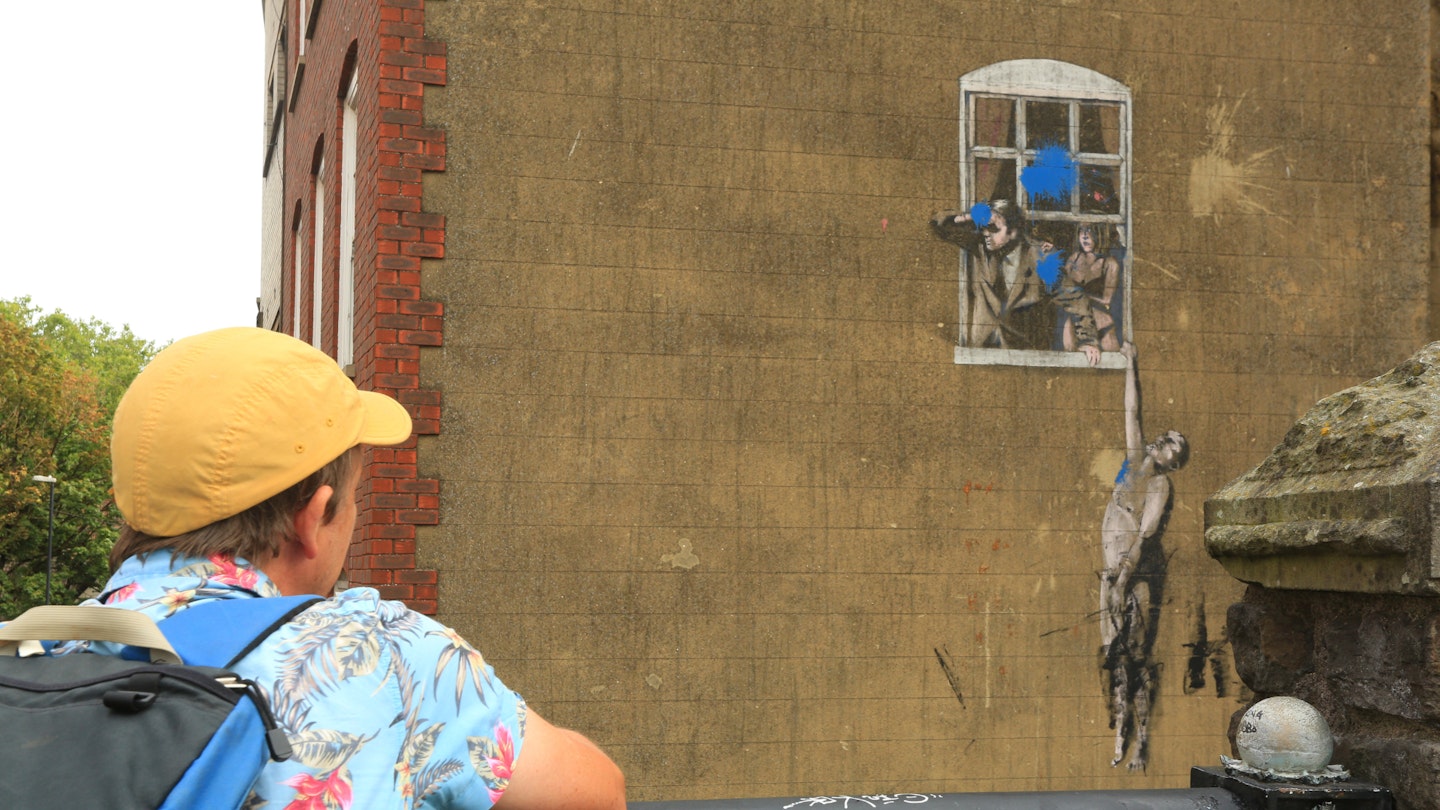
Known as the Well Hung Lover, we get the perfect view from the bottom of Bristol’s Park Street. On the wall opposite we see a naked man hanging from a window ledge, while another scans the horizon, his lingerie-clad wife behind. “The vote to protect this Banksy was a watershed moment in Bristol,” says John. “It changed the way the council was looking at what is crime and what is art.”
Within view of Bristol’s council buildings and on the side of what was a sexual health clinic, it shows Banksy’s genius for getting his art in just the right location. Like all his work, it is smart, funny and has instant impact. And it displays his signature stencil approach where time-consuming creativity takes place in a studio, cutting templates so that paintings can be sprayed in a matter of minutes.
In his book Banksy Wall and Piece, he says he got the idea when he was hiding from police under a train carriage and spotted a stencilled plate on the bottom of a fuel tank. “I realised I could just copy that style and make each letter three feet high…” he writes. In truth, there were plenty of artists already using this approach, most notably French graffiti star Blek le Rat. Like Banksy his work showed a penchant for rodents. “I’d been painting rats for three years before someone said ‘that’s clever it’s an anagram of art’ and I’d had to pretend I’d known that all along,” writes Banksy.
But how did he get this painting into its precarious location, 16ft above the pavement below? He simply booked a scaffolding company to set up a platform with a tarpaulin surround that allowed him to paint unseen. When the council ordered it to be taken down, they pulled back the plastic curtain on this provocative painting.
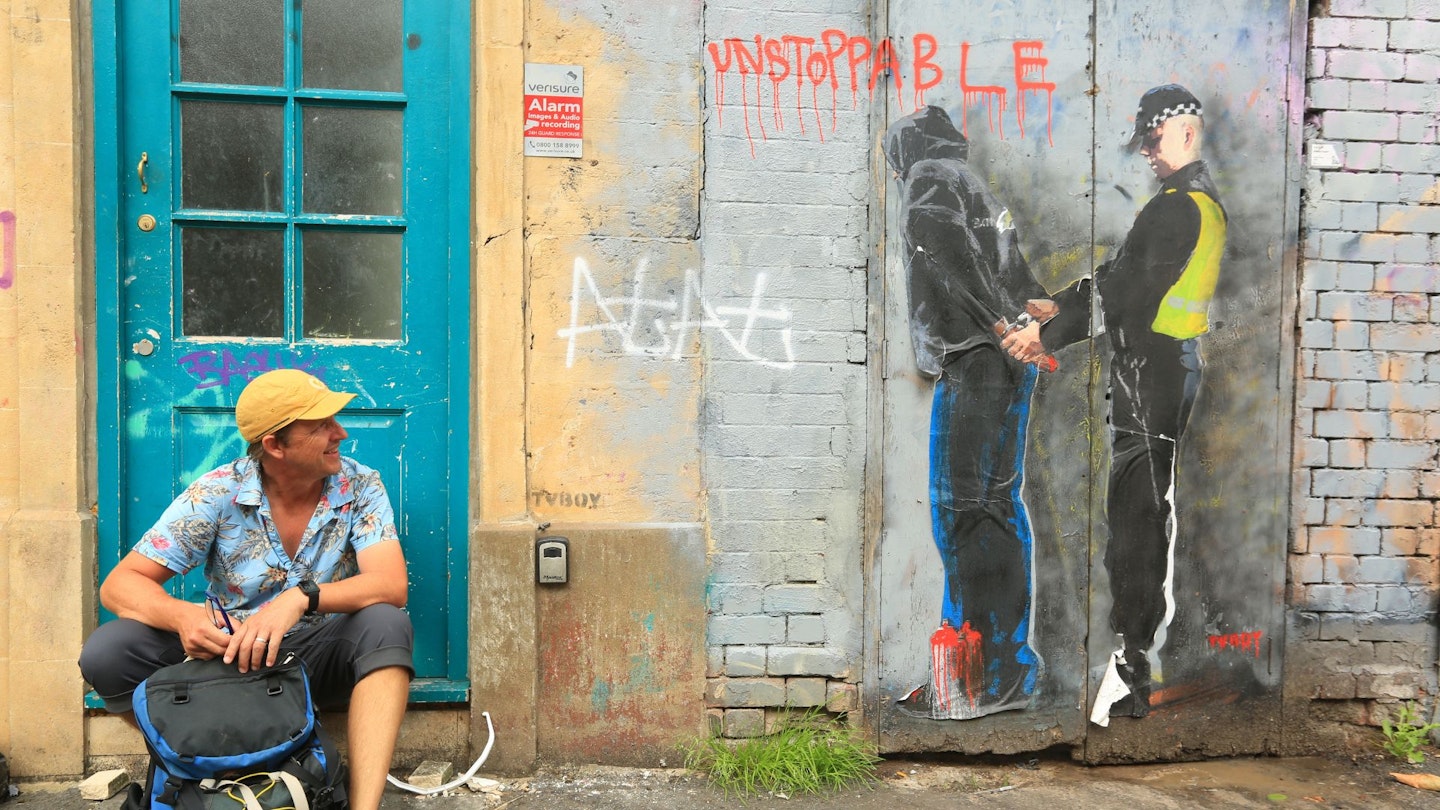
There’s much more to Bristol’s street art than Banksy and any walking tour of the city needs to visit Southville, home to UpFest. It’s an annual celebration of street art but even when the festival’s not on you can sometimes find artists at work. Over the last few days, I’ve been watching the artist Silent Hobo working on an elevated cherry picker, painting scenes of Bristol on a huge wall outside the local Lidl. But the lettering above that reads “Planet Local” can only be the work of one man.
Tom Bingle, aka Inkie, is a long-time Banksy collaborator, and his ‘Art Nouveau’ style can be seen everywhere as you wander along the river, past the harbour and into the city centre. His influences include Ancient Egyptian and Mayan culture, William Morris and Islamic geometry.
He and Banksy set up the Walls on Fire festival in 1998 and the See No Evil art festival in 2011 in the city centre. And it’s here on Nelson Street you can find the perfect riposte to anyone who asks: “Yes, but is it art?” Two sword fighters are the work of Irishman Conor Harrington, and with its dripping paint it straddles the line between classical and contemporary art. Another wall features a mother and baby by the artist El Mac who in 2003 was commissioned by the Groeninge Museum in Bruges to paint interpretations of classic Flemish Primitive paintings.
And then there’s Nick Walker’s The Vandal featuring a banker spilling a pot of red paint and a seemingly simplistic giant stickman (painted by the artist Stik). “Someone saw it and said ‘my three-year-old could do that’” says John, who offered to pay for the gantry and a can of paint to see “just how well they could do at night, 30 feet up a building with the police on their tail”.
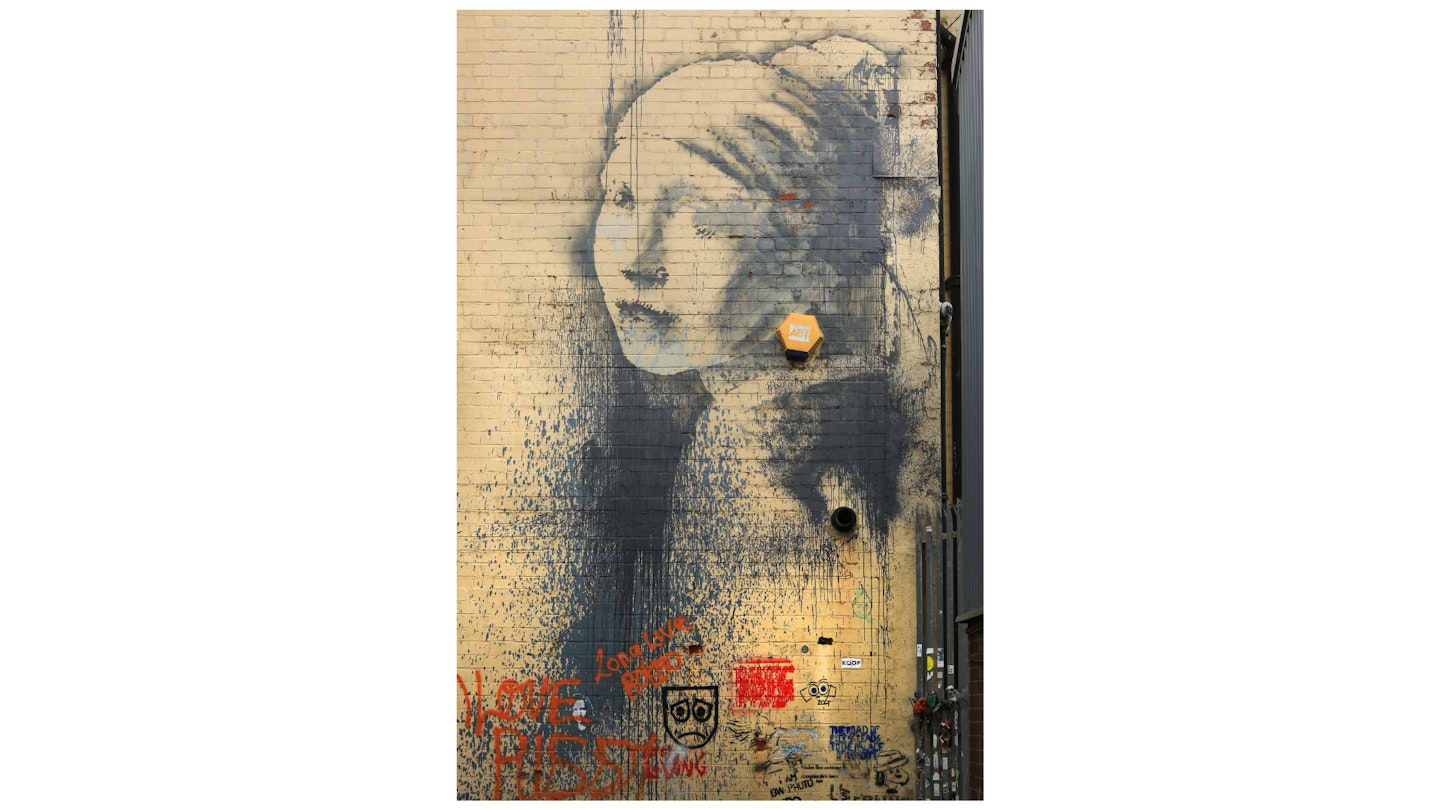
Back on the harbour, we find Banksy’s homage to Vermeer’s Girl With A Pearl Earring. Only this is the Girl With A Pierced Eardrum: a security alarm in place of the pearl. Positioned in a narrow gap between two buildings, it first appeared in 2014 – then early in the Covid pandemic a facemask was added for satirical good measure. It’s a short walk down the harbour side, past the SS Great Britain and the replica of The Matthew to the MShed museum, to find Banksy’s Grim Reaper. This was originally painted at the waterline of Bristol’s famous floating music venue, the Thekla. It was removed when the ship was in dry dock and is now on loan to the people of Bristol. Its value at auction could buy you a number of the multicoloured properties that line the leafier areas of nearby Clifton.
The sudden appearance of a Banksy can mean an instant windfall. The residents of one house in nearby Totterdown woke up to find he had painted a sneezing woman on the side of their wall. With the house already on the market they were left with a conundrum as to what to do with the artwork that one expert valued at between £3m-£5m.
When a Bristol youth boxing club was threatened with closure a Banksy suddenly appeared. Titled Mobile Lovers it featured a couple embracing, while checking their phones over each other’s shoulders. It sold for an undisclosed sum when the artist wrote to the club saying “as far as I am concerned, you can have it”.
At the back of Bristol’s Central Library, I meet art expert Ed Bartlett under one of Banksy’s least known works. The writing reads: ‘You don’t need planning permission to build castles in the sky’.
“The curved writing here was originally situated with two air vents to look like eyes and a smile but when one of those vents went and a new door was put in, they had to reinstate some of that work,” explains Ed, who runs the street art inspired cycle clothing company Kostüme.
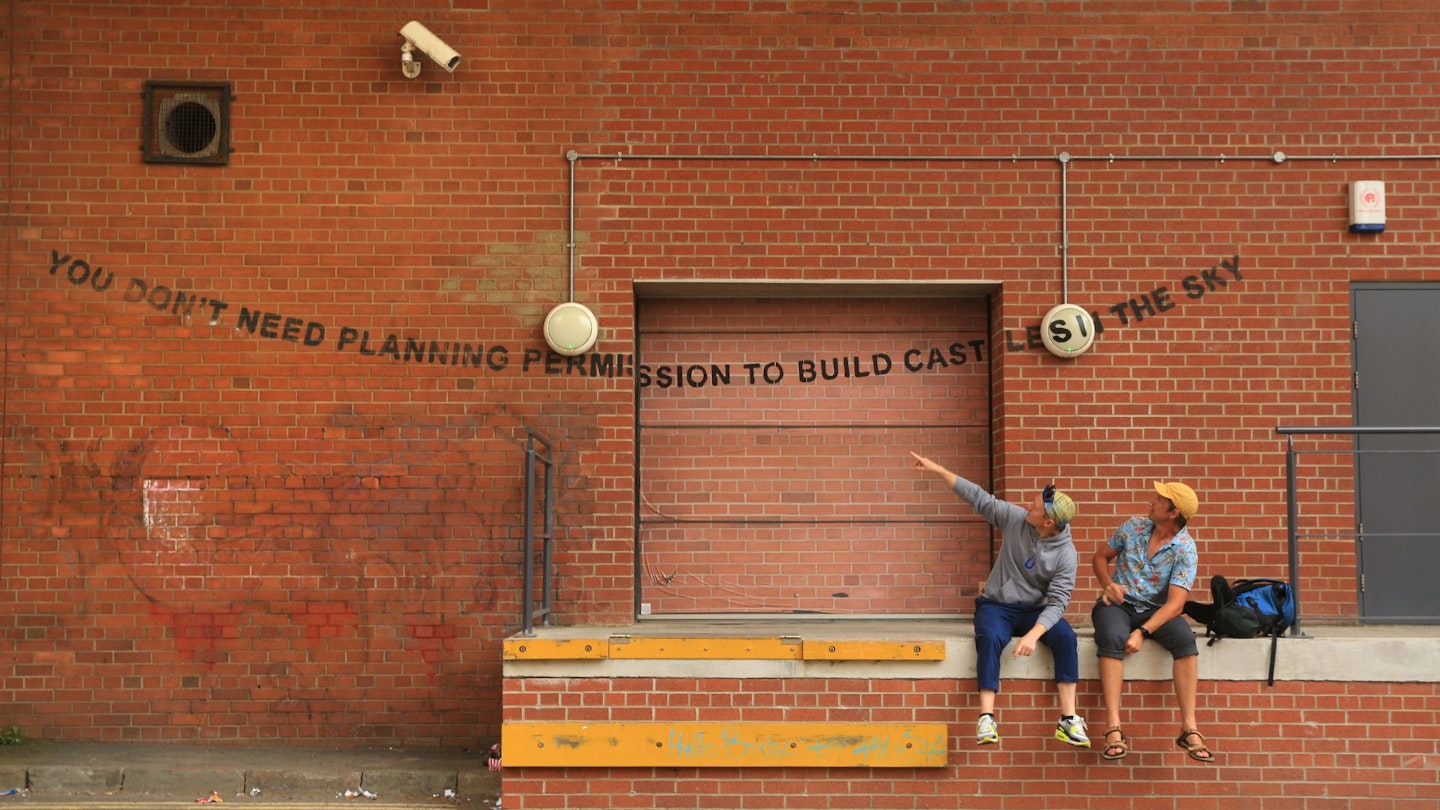
Ed escorts us to the top of Park Street, and the location of 2009’s Banksy vs. Bristol Museum, which saw the building transformed overnight with burnt out ice-cream vans, fishfingers swimming in a bowl and adapted old masters. The one remaining exhibit is titled Angel Bust and features a winged statue with a dripping pink paint pot over its head.
Outside the museum we find a faux-Banksy; one of his last remaining freehand art works on the walls of a nearby tattoo parlour; and a mousetrap stencil on the wall outside The Hare on the Hill pub. And not too far away, we finally track down one of his earliest works – a collaboration with Inkie and the artist Mobz from the early 90s titled Take the Money And Run. Only someone has decided to paint over the whole thing leaving just an almost unrecognisable early Banksy signature visible.
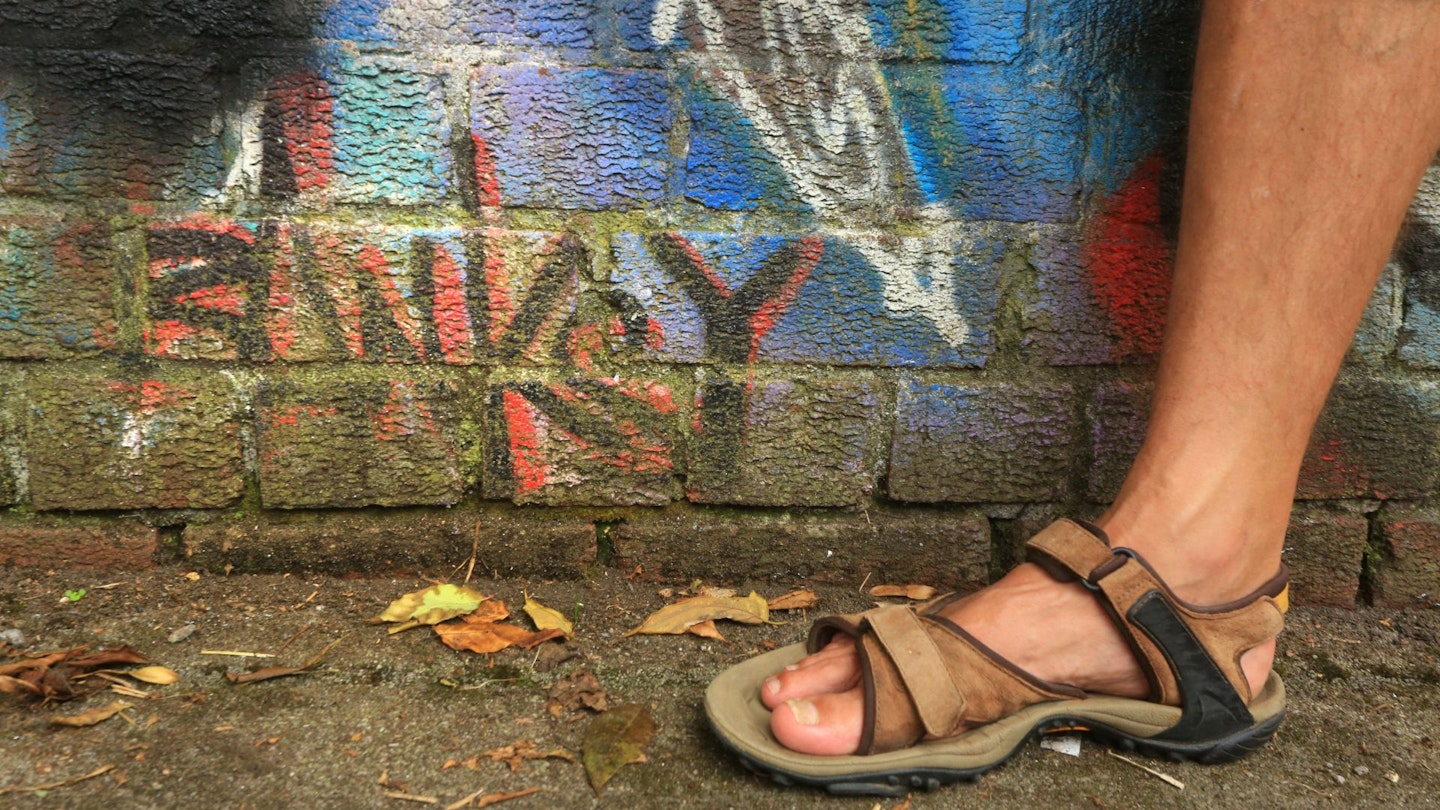
It’s late in the afternoon as we stroll back towards Stokes Croft, to find one of his most famous works, The Mild, Mild West, which shows a teddy bear launching a Molotov cocktail at advancing riot police. It was painted over three days in 1999, before he was truly anonymous, with people stopping to chat and take pictures.
“Everyone in Bristol knows who he is,” says John. “But not everyone approves of Banksy down here.” This painting and others around the city have been repeatedly attacked. Some people blame Banksy for gentrification of the area while other artists want to know why the council now protects Banksy’s work but still considers what they do to be vandalism.
But Banksy has left a legacy for the city. “He’s the prodigal son,” says John. “He’s a Bristol boy made good.”
His most notorious works happened far from Bristol, with paintings on walls in Gaza, inflatable Guantanamo prisoners installed on a Disneyland ride in California and the destruction of his Girl with a Red Balloon just minutes after it was sold for £1.4m at Sotheby’s. But it is the streets of Bristol that first inspired one of Britain’s most loved artists.
So if culture is really your thing, is a street art safari really worth your time? Banksy certainly thinks so. “Graffiti is not the lowest form of art,” he writes.
“Despite having to creep about at night and lie to your mum it’s actually the most honest artform available. There’s no elitism or hype, it exhibits on some of the best walls a town has to offer and nobody is put off by the price of admission.”
You can get instant access to our current issue of Country Walking, as well as access to our back issue archive, when you subscribe at greatmagazines.co.uk
